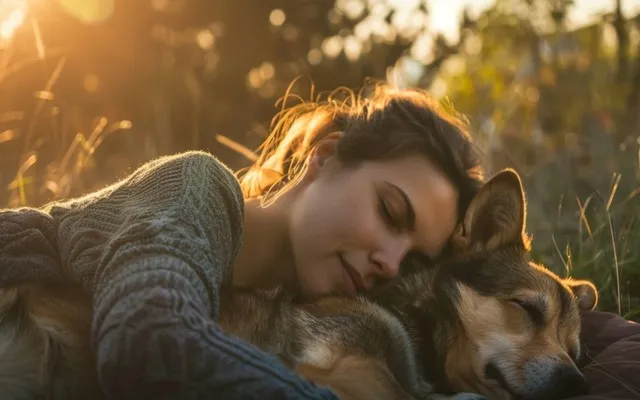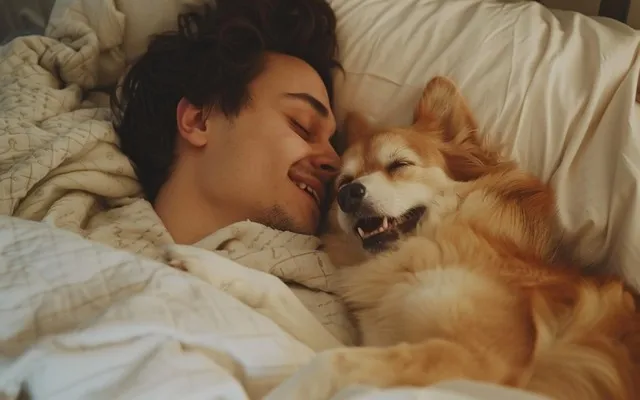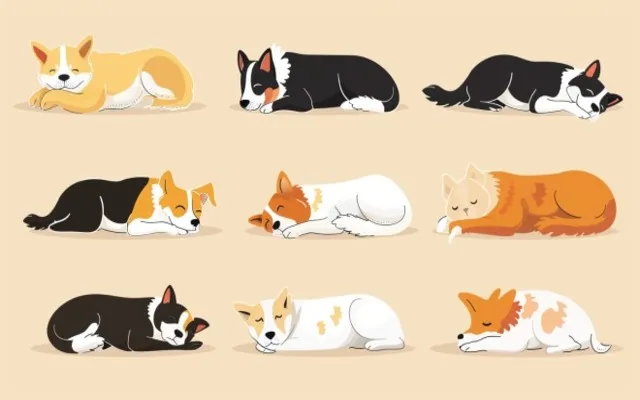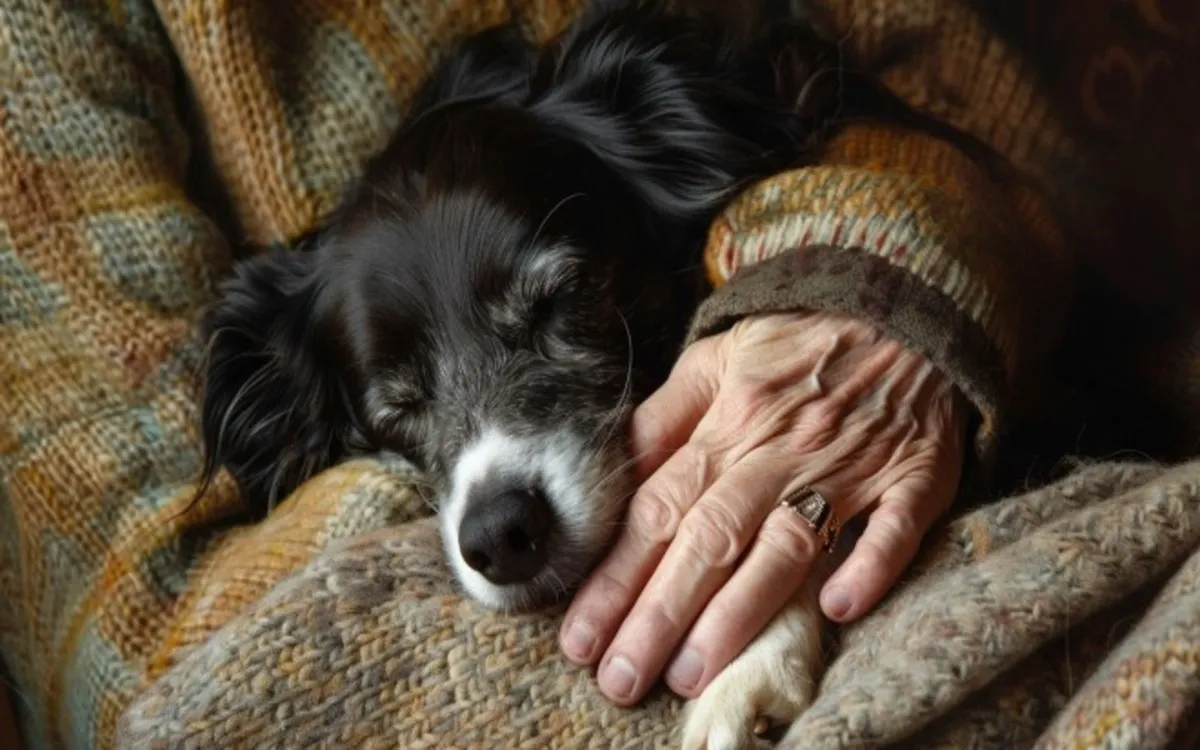Did you know that your nightly snuggle session with your dog has a long and fascinating history? Since the earliest days of dog domestication, our furry friends have sought comfort and warmth by sleeping near us. It’s a practice deeply ingrained in their instincts and in the special bond between dogs and humans.
Have you ever wondered why most dogs love sharing our beds, sometimes despite how little space they actually leave for us? This article dives into the complex reasons behind this adorable (and occasionally inconvenient) doggy behavior.
Let’s travel back in time for a moment! For thousands of years, the ancestors of our dogs lived as social creatures within packs. They slept together for warmth, protection from predators, and companionship. Even archaeological discoveries show evidence of ancient humans and their canine companions curled up together. Though modern dogs hardly face saber-toothed tigers in the night, those old instincts still reside deep within them.

It’s in Their Nature: The Whys Behind Your Dog’s Bedtime Habits
Pack Mentality
Dogs are descended from wolves, and wolves, like many social animals, instinctively sleep in groups. Your dog sees you as their chosen family – their pack! When they crawl onto your bed or curl up at your feet, they’re seeking a sense of belonging and a safe space within their pack’s “den.”

Love and Security
Snuggling with your dog floods both of your brains with oxytocin, the “cuddle hormone.” Oxytocin makes us feel happy, loved, and secure. For your dog, sharing your space and feeling you close provides a deep sense of safety and contentment. You are their protector, their best friend, and the key to a good night’s rest. Plus, who doesn’t love waking up to warm puppy snuggles?

Seeking Comfort and Security
Aside from the emotional comfort, your bed is probably one of the comfiest spots in the house! Pillows, fluffy blankets, and the perfect temperature – it’s the ultimate canine sleep haven. But it’s more than just the cozy factor – your scent lingers on those blankets. Being surrounded by a familiar smell that signifies safety and love is incredibly soothing, especially for a dog who might be prone to a bit of anxiousness. Think of it as their extra-special security blanket. Dogs’ anxiety also affects their sleep.
Your Dog’s Sleepytime Secrets: Understanding Their Sleep Language
Dogs communicate with us constantly, even in their sleep! Pay close attention to their sleeping positions and little nighttime quirks – they might be saying more than you think. We’ll explore how your dog’s body language and subtle nighttime sounds can be clues to their emotional state and desire for closeness when it’s time to turn in for the night.
Sleep Position Decoding
- Curled in a ball near you: This classic position shows comfort, warmth seeking, and vulnerability. Your dog feels totally safe and at ease with you as their protector.
- Sprawled out belly up: This relaxed position usually means your dog is feeling confident, secure, and perhaps a bit warm.
- Head on your pillow: Your dog is vying for extra closeness and may be trying to mix their scent with yours, showing their strong attachment.

Dreaming Dogs and Nighttime Sounds
Soft sighs, whimpers, or the occasional twitching legs and little woofs tell us our pups are dreaming! While most signs of dreaming are adorable, frequent whimpers or agitation might suggest your dog is having a not-so-pleasant dream and may appreciate a gentle reassuring touch from you.
Sleeping Together: Is it Right for You and Your Dog?
Benefits of Co-Sleeping
- Stress and Anxiety Relief: For both you and your dog! Cuddling releases those feel-good hormones which can reduce stress and create a sense of calm. It’s a powerful mood booster, especially if either of you struggles with nighttime anxieties.
- Enhanced Bond and Understanding: Sharing close quarters strengthens the human-canine bond. You become more in tune with your dog’s sleep patterns, potential discomforts, and how they express themselves when they feel happy and safe.
- Warmth and Security: Dogs can act like little furry hot water bottles! This is especially welcome on chilly nights. Additionally, your presence creates a sense of security that allows for deeper relaxation and a better quality of sleep (at least sometimes!).
- Potential Sleep Improvement: For some people, the rhythmic breathing and warmth of a furry companion can be incredibly soothing, leading to better sleep. However, we need to be honest – the opposite is true for many others!
Drawbacks and Considerations
- Disrupted Sleep: Dogs move, snore, and dream! If you’re a light sleeper, these nighttime antics might mean tossing and turning for you.
- Allergies and Hygiene: If you’re prone to allergies, sharing a bed with a dog could be problematic. It’s also important to be mindful of keeping their paws clean and bedding washed regularly.
- Limited Personal Space: Let’s face it, even small dogs know how to take up way more than their fair share of the bed. It’s definitely a compromise in how much space you have for yourself.
- Potential for Behavioral Issues: Though rare, some dogs may become overly possessive of your bed or develop demanding habits if clear boundaries aren’t established.
Setting Boundaries for Better Bedtime
- Training is Key: Don’t worry, not all hope is lost for a good night’s sleep! With a little training and consistency, you can address most of the potential drawbacks of co-sleeping.
- Crate Training as an Option: If your dog already enjoys their crate, it can be a cozy and secure alternative to your bed. However, crating shouldn’t be viewed as a punishment – create positive associations through treats and comfy bedding, so it becomes their own special sleeping space.
- Teaching a “Go to Bed” Command: If you want to share the bed but still need some space or want your dog to sleep at the foot of the bed, teach a simple command like “go to your bed” or “settle.” Mark and reward the desired position and gradually increase the time they stay there before getting a treat.
Conclusion
Sleeping with your dog is deeply rooted in instinctual needs for safety, comfort, and love. For many, it offers profound emotional benefits and deepens the human-canine bond. However, it’s important to honestly consider your own sleep habits, your dog’s needs, and any potential disruptions. Thankfully, with a little training, you can set up your sleeping arrangement to work for both you and your beloved furry companion. Ultimately, whether you become full-fledged bed-sharing buddies or find another arrangement that works, remember that the love you share transcends where you each sleep at night.
FAQs
Why does my dog sleep on my pillow – why do they do that and is it okay?
This question is frequently asked and taps into a common quirky dog behavior. It also has the potential for hygiene considerations, increasing its overall value.
Can my dog sense my emotions and try to comfort me at night?
This unique question directly addresses the potential for emotional support dogs provide to their humans, creating a strong opportunity for deeper exploration within your article.
Why does my dog sleep with their back to me? Does it mean they don’t trust me?
This takes a common question about sleeping positions and adds a layer of emotional nuance. Trust is a crucial element within the human-dog bond.
My dog prefers sleeping under the covers – is this normal?
This highlights a less-frequently discussed behavior that speaks to canine denning instincts.

I’m Ashley Fowler and dogs have always been my companions from my earliest memories. Growing up, our family dog was my confidant, adventure buddy and sometimes partner in crime (sorry mom, about the chewed shoes!). That bond sparked a lifelong passion for learning about dogs – their unique personalities, their histories, and the special ways they fit into our lives. MDogsW is my way of sharing that passion and hopefully helping others experience the joy of finding their perfect puppy. When I’m not researching dog breeds, you can usually find me hiking with my trusty Beagle by my side or curled up with a cozy blanket, a cup of tea, and a stack of dog breed books.

